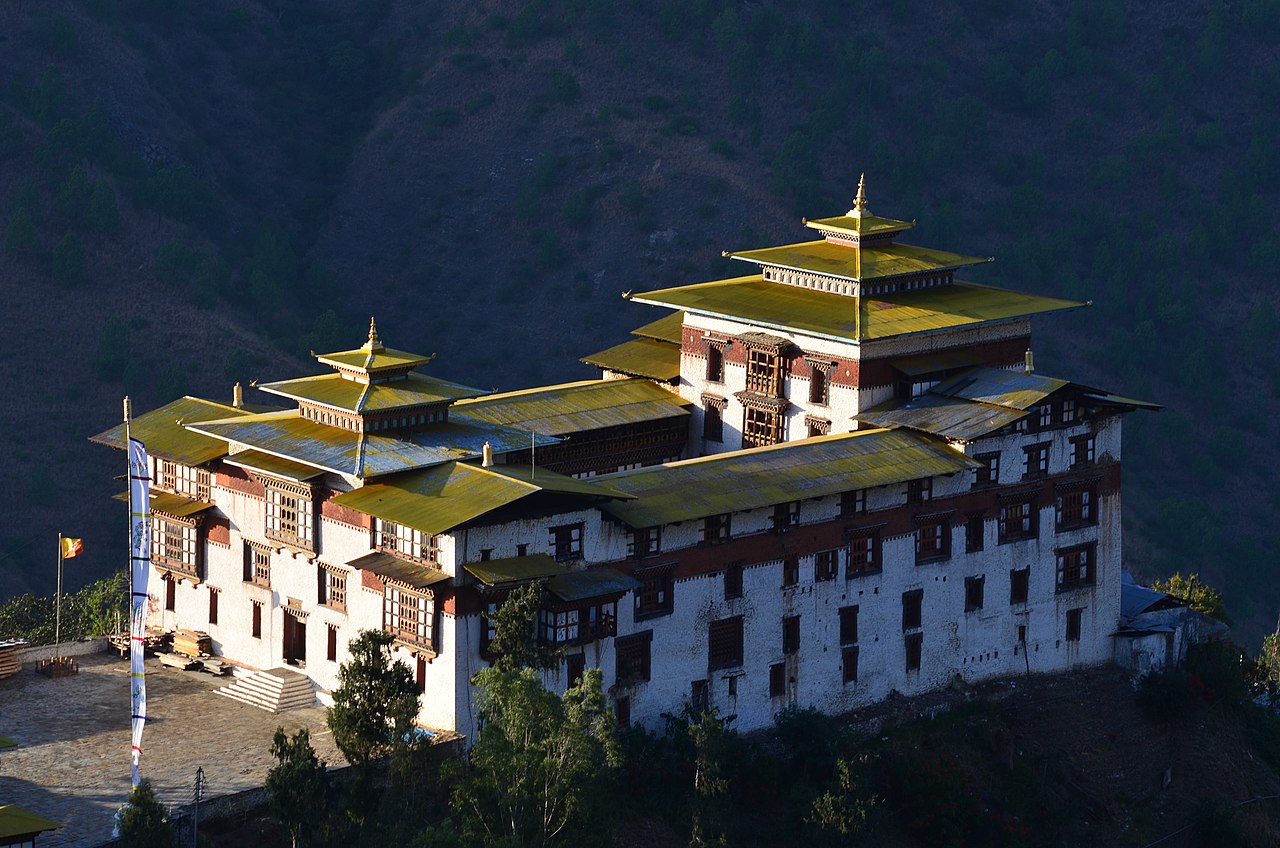131 Bhutan

Divided diagonally from the lower hoist-side corner. The background colors represent spiritual and secular powers within Bhutan. The upper triangle is yellow which denotes the ruling dynasty and the lower triangle is orange which is associated with Buddhism. Centered along the dividing line is a large black and white dragon facing away from the hoist side. The dragon, called the Druk (Thunder Dragon), is the emblem of the nation. Its white color stands for purity and the jewels in its claws symbolize wealth.
Flag courtesy of the CIA World Factbook

Map courtesy of the CIA World Factbook

Trashigang Dzong, built in 1659
Government
According to Britannica, until the 1950s, Bhutan was an absolute monarchy whose sovereign was styled the druk gyalpo (“dragon king”). During the second half of the 20th century, the monarchs increasingly divested themselves of their power, and in 2008 King Jigme Khesar Namgyal Wangchuk, the fifth in a royal line that had been established in 1907, completed the transfer of governmental authority to a popularly elected, multiparty, bicameral legislature. While the monarch remained the titular head of state, the prime minister (generally expected to be the leader of the majority party in the legislature) became the actual head of government.
Historically, the government of Bhutan was autocratic, with no law codes or courts or any of the common features of public administration. Major change came, however, when the third monarch, King Jigme Dorji Wangchuk (reigned 1952–72), began to restructure the country’s government to share administrative responsibility, which formerly was his alone. In 1953 a national assembly known as the Tshogdu was established in Bhutan through the king’s initiative. It had 151 members, who were elected by village headmen or chosen by the king and the country’s official Buddhist monastic order. The Tshogdu met twice a year and passed legislation enacted by the king. The Royal Advisory Council was established in 1965 to advise the king and his ministers on important questions and to supervise the implementation of government programs and policies. The Council of Ministers, composed of the heads of the various government departments, was set up in 1968; the ministers were appointed by the king, and their appointments were ratified by the Tshogdu. The Royal Advisory Council and the Council of Ministers, along with representatives from the clergy, constituted Bhutan’s cabinet. The state Buddhist monastic order was involved in government at many levels, and its priests exerted considerable influence.
Upon his death in 1972, Jigme Dorji Wangchuk was succeeded by his son, King Jigme Singye Wangchuk (reigned 1972–2006), who continued the process of reforming the government. Major changes were introduced in 1998, when the king dissolved the cabinet to have it reconstituted, in part, through election by the Tshogdu. Moreover, the monarch transferred most of his administrative duties to the cabinet and granted to the Tshodgu the authority to remove him through a vote of no confidence. In other words, while the king retained his role as head of state, he relinquished his power as head of government to the Tshogdu.
On December 14, 2006, Jigme Singye Wangchuk abdicated, passing the throne to his Oxford-educated son, Jigme Khesar Namgyal Wangchuk. This event catalyzed the country’s transition to a fully democratic government. Over the next year the public was trained in the democratic process through a mock vote, and the country’s first official elections, for seats in the National Council, the upper house of a new bicameral parliament, were held on December 31, 2007. Elections for the National Assembly, the lower house, took place in March 2008, completing the conversion of Bhutan’s government to a parliamentary democracy. A new constitution was promulgated on July 18, 2008.
For administrative purposes, Bhutan is divided into some 20 dzongkhags (districts), each with a district officer who is responsible to the minister of home affairs. Some of the districts are divided further into dungkhags (subdistricts). Each dzongkhag and dungkhag encompasses a number of gewogs (groups of villages). Gewogs are governed by elected councils, which are led by a chairperson and a deputy chairperson, with five-year terms. Some areas are designated as municipalities and operate on the same administrative level as the gewogs.
Bhutan’s legal code is based upon traditional Buddhist precepts. In 1968 the judicial system was separated from the executive and legislative branches of government, and a high court was established, primarily to hear appeals from district-level courts. The Supreme Court was established in 2009 as the judicial body with the authority to interpret the newly adopted constitution, and it also hears appeals from the High Court.
Bhutan Civil Aviation Authority (BCAA)
Bhutan Civil Aviation Authority (BCAA) is the safe and secure civil aviation system in the region. Their mission is to:
- Ensure aviation safety and security standards through continuous oversight functions in line with the best international practices.
- Provide continued effective oversight functions through competent professionals.
- Facilitate air connectivity through international collaboration.
- Regulate and foster general aviation activities.
Airspace
SkyVector – Google Maps – ADS-B Exchange
ICAO countries publish an Aeronautical Information Publication (AIP). This document is divided into three parts: General (GEN), En Route (ENR) and Aerodromes (AD). ENR 1.4 details the types of airspace classes they chose to adopt from classes A through G.
Drone Regulations
Advanced Air Mobility (AAM) Regulations & Policies
None found by the author.
However, should you, the reader, happen to stumble across something to the contrary, please email the author at FISHE5CA@erau.edu and you may be mentioned in the ACKNOWLEDGEMENTS section of this book by way of thanks for contributing to this free eBook!
Advanced Air Mobility (AAM) News
None found by the author.
However, should you, the reader, happen to stumble across something to the contrary, please email the author at FISHE5CA@erau.edu and you may be mentioned in the ACKNOWLEDGEMENTS section of this book by way of thanks for contributing to this free eBook!
Short Essay Questions
Scenario-Based Question
You have been hired by a Drone Startup Company. Your boss has immediately assigned this job to you.
They need you to prepare a one-page memo detailing the legalities of using a drone to film the building, pictured above.
They need you to mention any national laws and local ordinances.
They specifically want to know what airspace (insert pictures) you will be operating in and whether or not you need an airspace authorization.
Does it matter whether or not you are a citizen of the country?
Lastly, there is a bonus for you if, as you scroll through this chapter, you find any typos or broken links!
Short Essay Questions
- What are the drone categories?
- How is registration addressed?
- How is remote ID addressed?
- What are the model aircraft rules?
- What are the commercial drone rules?
- Are there waivers or exemptions to the rules? If so, for what?
- Would you share a link to an interactive airspace map?
- How is BVLOS addressed?
- How can you fly drones at night?
- How can you fly drones over people?
- Where do you find drone NOTAMs?
- What are the rules for drone maintenance?
- What are the rules for an SMS program?
- What are some unique rules not mentioned above?
- What are the C-UAS rules?
- What are the AAM rules?

